Japanese space-saving ideas a minimalist fantasy, Japanese interior design. The interior design and architecture of this island nation are still influenced by the desire to embrace wabi-sabi, a Zen philosophy, and the urge to resist natural forces. A Japanese kitchen is defined by a harmony of simplicity, nuance, and nature.
For a small or limited space, a galley kitchen layout is also popular. In this design, kitchen elements are placed along two parallel walls, creating a corridor-like setup. This layout is efficient for single-cook kitchens and provides easy access to everything within arm’s reach.
If you’re interested in a Japanese-style kitchen for your small space, consider incorporating the following elements:
- Simplicity: Embrace clean lines, minimalistic design, and a clutter-free environment.
- Natural Materials: Use wood, bamboo, stone, and other natural materials for a warm and inviting ambiance.
- Neutral Color Palette: Opt for neutral and earthy tones inspired by nature to create a calm and balanced atmosphere.
- Functional Layout: Prioritize a functional layout that optimizes workflow and minimizes unnecessary steps.
- Open Shelving: Incorporate open shelving to display kitchen items while maintaining an airy feel.
- Compact Appliances: Choose compact appliances that fit well in the limited space while maintaining functionality.
- Zen Elements: Infuse Zen-inspired elements like indoor plants, bamboo accents, and soothing lighting for a tranquil ambiance.
- Hidden Storage: Utilize smart storage solutions to keep the space organized and clutter-free.
- Efficient Lighting: Use natural light as much as possible and complement it with soft, ambient lighting fixtures.
- Simple Decor: Add minimalistic decor items that contribute to the overall Zen aesthetic without overwhelming the space.
Every few decades, homes undergo renovations, yet this doesn’t alter their simple design. Japanese architecture’s enviable harmony and simplicity have found homes all over the world. The top 10 Japanese kitchen design trends that are impacting interiors all over the world are listed here.
Wood & Natural Colours
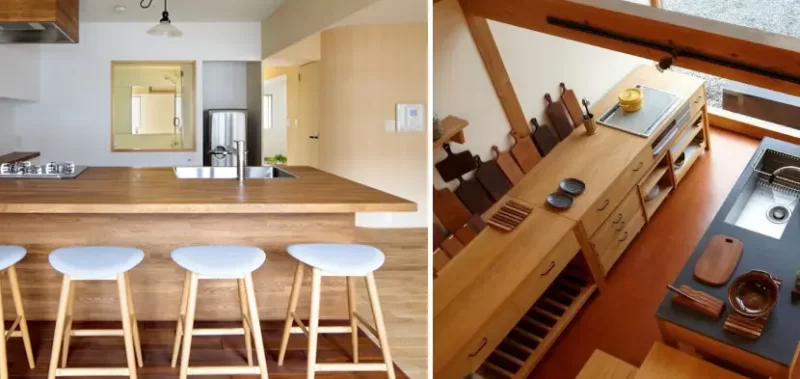
A block of light wood with a noticeable grain, like pine, is frequently used in Japanese kitchens. Wood is a great building material on the island because of the humid temperature and erratic weather. A wood-beam structure is the best type to withstand hurricanes, typhoons, and mold.
Traditional Japanese dwellings’ foundational elements were exposed for inspection, giving some of their interiors a minimalist feel. The growth of wood construction was aided by the Edo era’s ban on the use of metal as well as the strength and availability of lumber.
Modern kitchens also use natural materials, but they may also use steel, concrete, and stone. White, browns, greys, and black make up the color scheme, which nevertheless remains neutral.
Cabinet Screens
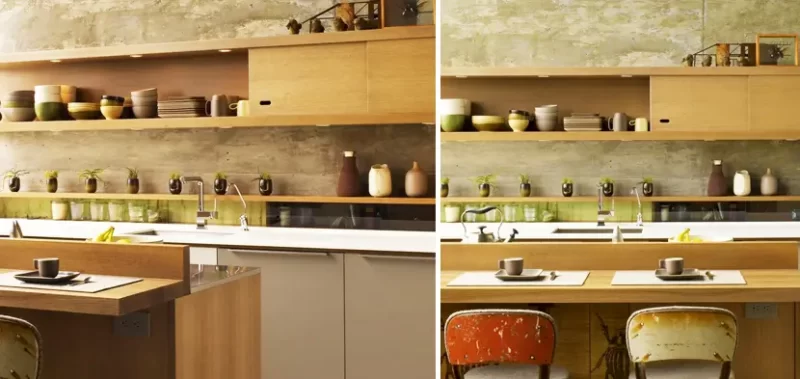
Cabinets in Japanese kitchens often have screens similar to shoji screens instead of hinged cabinetry. Traditional Shoji screens that are made from washi paper with a bamboo or wooden frame still feature in most Japanese homes today. These space-saving and efficient screens are affordable and lightweight. Kitchens that do have hinged cabinet doors don’t have door handles; they are regarded as unnecessary additions.
Integrated Living

Given how time-consuming Japanese cooking can be, integrated living encourages interaction between the cook and the rest of the family. However, it is not the only factor favoring an open-plan design.
Japan has a 30-year renovation tradition, meaning that before a house is 30 years old, everything save the original framework is rebuilt. The goal of architects is to maximize natural ventilation, which leads to open floor plans with few furnishings.
Open-plan living is required because homes are frequently compact and have numerous levels. In leveled homes, immovable objects like walls restrict freedom of movement and functionality. Therefore, wherever appropriate, thin shoji screens serve as room dividers.
Tiny Kitchen, Tiny Tools
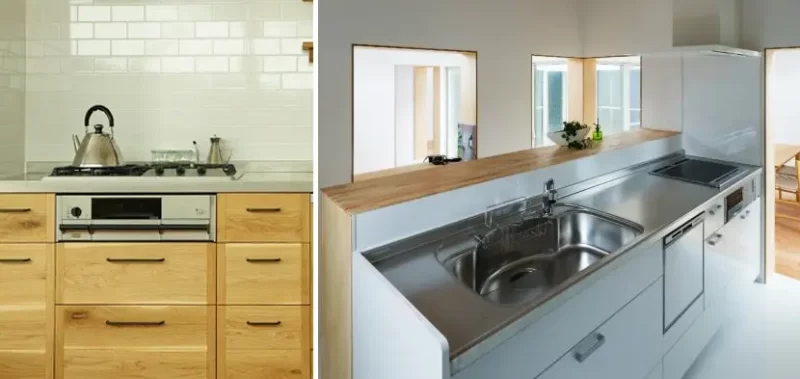
B The kitchen only occupies a modest portion of the average Japanese home’s 121.7 m2 space. The purpose of a Japanese kitchen is somewhat distinct from that of a Western kitchen and is based on custom. The Japanese practically never mix their personal and social lives, so a large kitchen is not required for entertaining.
Small appliances are necessary for very tiny kitchens, especially in micro homes. You can anticipate a two-plate gas or induction burner with a small fish broiler for cooking. Dishwashers and built-in ovens are uncommon, and convection microwaves are small. In contrast to the rest of the utilities, wash basins are enormous. Given how time-consuming Japanese cooking can be, including.
Floating Shelves
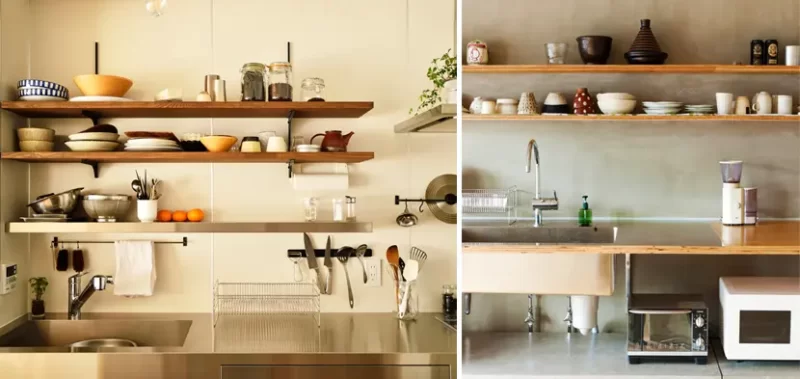
Japanese kitchens rarely have upper cabinets because they value the simplicity of open shelving. On one wall of a kitchen, there are typically one or two floating shelves that hold dishes and glasses in a naturalistic arrangement. Knives for cutting and chopping are kept on a magnetic strip next to open shelves. There is no clutter or obvious adornment on these shelves.
Suspended Shelving
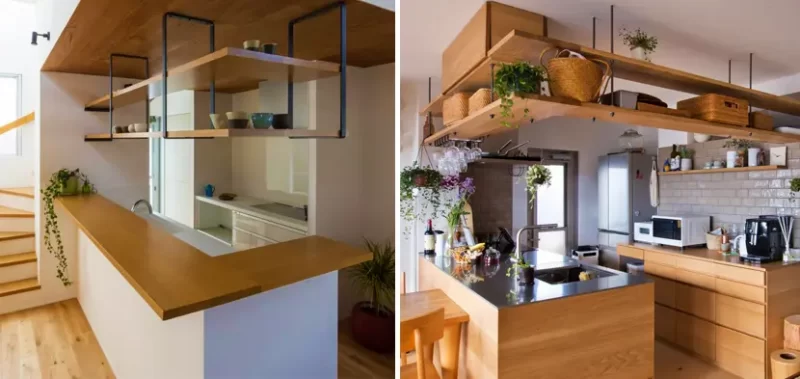
Suspended racks, which resemble open shelves but are too high for useful storage, are a modern addition to Japanese kitchens. The shelves, which can be kept empty or stocked with plants and less-used goods, are suspended from metal or wood strips.
The Hidden Worktop
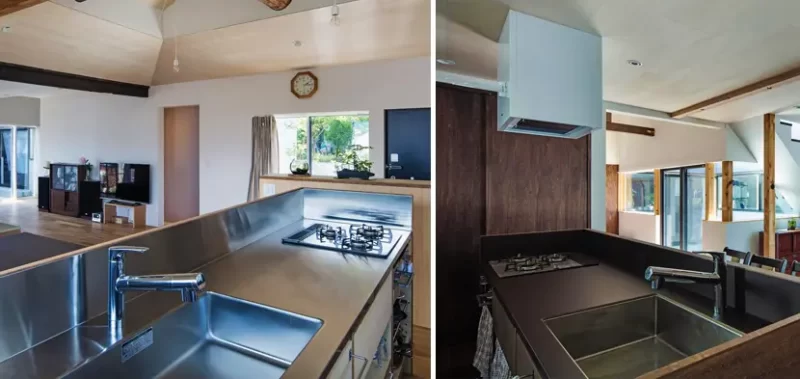
Some kitchen worktops include partitions that conceal the preparation and cooking areas due to open-plan designs. The barrier gets rid of clutter’s visual presence. The Canso principle states that clutter prevents a person from having the mental clarity necessary to concentrate on what is most important. Clutter-free homes adhere to this rule.
Adjacent Dining

ALTS Design & Arakawa Architects
Frequently, the kitchen counter or an area close to it serves as the dining space. Families frequently eat there, so it serves as more than just a breakfast nook. Families spend a lot of time and energy cooking, so having a dining space close by makes it easy to socialize.
The T-shape, where the seating area is parallel to the kitchen counter, and the l-shape, where the table is an extension of the kitchen counter, are popular possibilities. The Shibui concept, which is understated beauty via subtle contrast, is illustrated by the fact that different chairs frequently accompany the dining table.
Hanging Utensils

As a result of the smaller size of Japanese kitchens, hanging smaller objects is made easier by different storage options such as S-hook hangers. So, to add to the kitchen’s straightforward and basic appearance, pots and kitchenware are arranged along a wall.
The Minimum of Minimalism
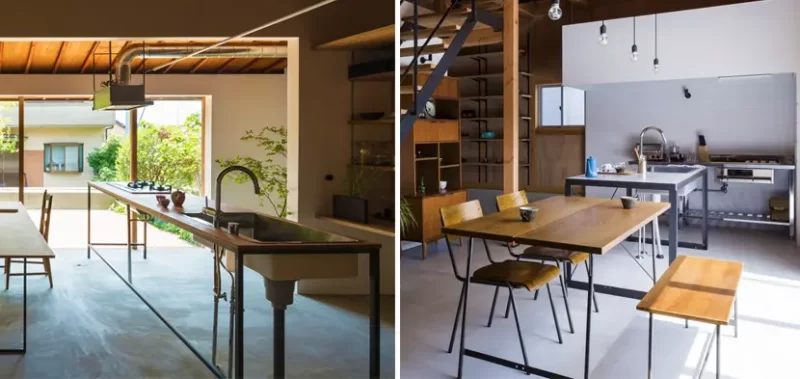
Non-essentials, like adornment, disappear because simplicity and tranquility are required. The “aesthetic ideal of emptiness” is used in the design of dwellings to show naturalness. Kitchens may appear unpolished and industrial due to the minimalistic trend. There is symbolism in the design, though, as imperfections are unavoidable in life and help to balance the aesthetic.
Japanese space-saving ideas
Important!
Lack of space can prevent the use of sliding partitions made of glass or bamboo — a characteristic feature of the chosen style. This means that zoning is impossible, and therefore a separate selection of items for each functional segment is impossible.
Japanese-style kitchen 2023 is a popular trend in interior design. Designers and apartment owners often turn to him. This style is in demand along with other equally well-known ones at the present time. A Japanese-style kitchen with an interior thought out to the smallest detail allows you to give the atmosphere an oriental spirit, give the room a unique grace and create a harmonious atmosphere in which all family members will be pleased to be.

I joined Appartenville in February 2021 as a content editor. After studying English literature at university, I worked as an e-commerce website editor, content author, and purchasing intern for several independent luxury and lifestyle retail companies. My role at Appartenville combines my love, experience, and passion for the world of design and the desire to create inspiring written content. As for my personal style, I am a big fan of color and drawing, especially I like the pastel color scheme. I also enjoy discovering new trends, brands, and products, whether it’s fashion, interior design, or lifestyle my wish list for buying new things is endless.
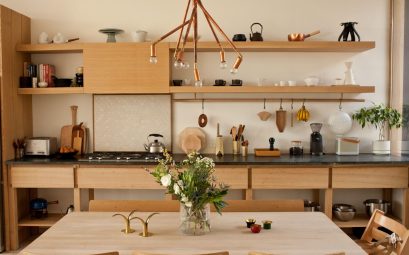
Leave a Reply